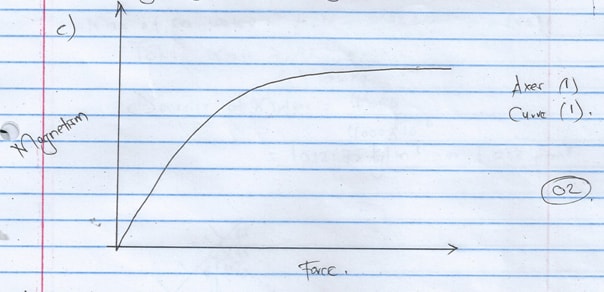- Sleeve scale = 17.50 mm
Thimble scale 28 x 0.01 = 0.28 mm
Total reading = 17.50 + 0.28
= 17.78 mm
= 1.778 x 10-2 m - There is a weaker intermolecular force in liquids than in solids ü1
- Rectilinear propagation of light/ light travels in a straight lineü1
- Magnetism is easily induced in them ü1. The dipoles of the keepers from a closed loop with those in the magnets hence protecting the magnets from being demagnetized
- n = 360/θ= −1
360/x−1=7
360/x=8
8 x = 3600
x = 45
-
- Adding impurities eg detergents
- Increasing the temperature/heating the water
- Bulb should be small and made of thin material
- Radiation
- Gauze conducts heat away and the temperature above is lower than ignition temperature of the gas. ü1. It burns above the gauze because the gauze become hotter than the ignition temperature of the gas required to ignite it. ü1
-
- Principle of moments states that for a system in equilibrium, the sum of clockwise moment about a point must be equal to the sum of the anticlockwise moment about the same point
- Clockwise moment = Anticlockwise moment
0.16 (x) = 0.24 ( 1−x)
0.16 x = 0.24−0.24 x
0.4x = 0.24
x = 0.6
the pivot is 0.6 m from 16 g mass
-
- Atmospheric pressure at sea levels
- Leakages of the values and pistons of the lift pump
- When the temperature increases to high levels the bimetallic expands and bends. Brass expands more than iron therefore it bends such that it makes the contacts completing the circuit.
- The negative charge on the rod initially neutralizes the positive charge on the leaf and the plate. As the rod is moved towards the cap, electrons are repelled to the leaf making it fall. As the rod is brought nearer, the excess negative charge flows to the leaf and plate where they repel each other making the leaf to rise.
- Hard magnetic materials are difficult to magnetize but once magnetized they retain magnetism for a long time while soft magnetic materials are magnetized easily but do not retain their magnetism.
-
Mass of water = 90 – 70 = 20g
Density of water = 1000 kg/m3 = 1 g/cm 3
Volume of water =mass/density=20/1=20cm3
Volume of water = volume of liquid A
Mass of liquid A = 94 g – 70 g = 24 g
Density of liquid A =mass/volume=24/20
= 1.2 g/cm 3 or 1200 kg/m3
-
- The pressure in the pen is higher than that outside the pen (Atmospheric pressure) this causes the ink to flow outwards due to difference in pressure.
- P = F/A=120/0.006=20000Nm2
F = P X A
= 20000 X 0.50
= 10, 000N -
- Should be incompressibleShould be non corrosive
- Should have high boiling point and low melting point.
- p1h1g1 = p2 h2 g
1360 x 1.25 x 10 =(74−x/100)x 13.6 x 10
17000 = (74–x) 1360
17000 = 100640 – 1360 x
1360x = 83640
x = 61.5 m
- Paraffin less dense than water hence could occupy larger column to balance with pressure due to water column.
- L1 lights brighter than L2 and L3
-
- V = 4/3πr3
=4/3×3.142×(0.03)3
= 1.13112 x 10-4 cm3 - A=πr2
= 3.142 x 102
= 314.2 cm2 - V drop = V patch
1.13112 x 10-4 = 314 x t
t =1.13112 x 10-4/314
= 3.6023 x 10-7 cm -
- oil drop is spherical
- oil patch is circular
- oil spread until it is monolayer
- V = 4/3πr3
-
- Like poles repel unlike poles attract
-
- The magnet is repelled. End A becomes a north on magnetization
- Easily magnetized and demagnetized.

- Attraction occurs between unlike poles of a magnet and can also occur between a magnet and un magnetised magnetic material
-
-

- Watches or measuring instruments
-
- Density of mixture =mass of mixture/volume of mixture
total volume = 1800 + 2200 = 4000 cm3
Mass of sea water = P x V =1000x1800/100000 = 1.8 kg
Mass of sea water = P x V = 2025x2200/100000= 2.255 kg
total mass = 1.8 + 2.255= 4.055 kg
Density of mixture =4.055/4000x10-6
= 1012.75 kg/m3 or 1.013 g/cm3 -

-
- Base area
- The position of the C.O.G
- Glass is a poor conductor of heat for thick glass inner wall gains heat and expands while outer wall does not. The tension between the two glass break the glass.
-
- A – Neutral equilibrium
- B – Stable equilibrim
-
- It is a force that makes the surface of a liquid to behave like a stretched elastic skin
- Bubble flattens to a film and moves up the funnel in order to make its surface area be as small as possible due to surface tension.
Join our whatsapp group for latest updates
Tap Here to Download for 50/-
Get on WhatsApp for 50/-
Download PHYSICS Marking Scheme - Form 2 End of Term 1 2019 Examinations.
Tap Here to Download for 50/-
Get on WhatsApp for 50/-
Why download?
- ✔ To read offline at any time.
- ✔ To Print at your convenience
- ✔ Share Easily with Friends / Students

